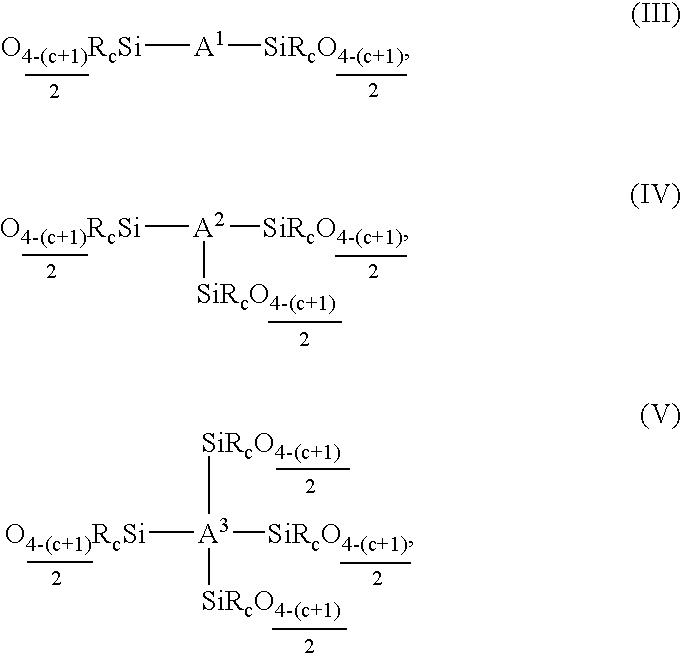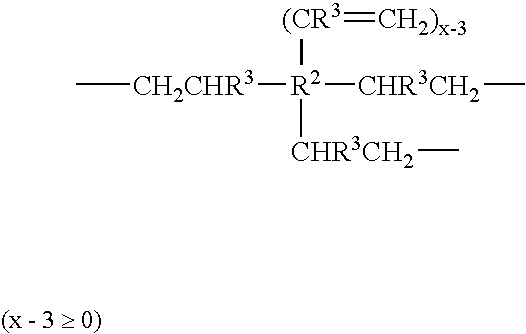Use of siloxane copolymers comprising alkenyl groups as antimisting additives in cross-linkable silicone coating compositions
- Summary
- Abstract
- Description
- Claims
- Application Information
AI Technical Summary
Benefits of technology
Problems solved by technology
Method used
Image
Examples
example 1
[0201]At 25° C. 683 g of an α,ω-dihydrosiloxane of average chain length Si225 and 7.72 g of trivinylcyclohexane are dissolved in 1036 g of toluene (C═C / SiH=1.74) and with thorough stirring a quantity of a 1% strength (based on elemental platinum) solution of a platinum-1,3-divinyl-1,1,3,3-tetramethyldisiloxane complex in an α,ω-divinyldimethylpolysiloxane having a viscosity of 1000 mPa·s at 25° C. (a solution of the catalyst known as the Karstedt catalyst, whose preparation is described in U.S. Pat. No. 3,775,452) is added such that the solution contains 10 ppm platinum. Over the course of 4 h at 30° C. the viscosity becomes very much greater until finally 3900 mm2 / s (25° C.) are reached. 2072 g of divinyl-terminated polydimethylsiloxane with 200 mm2 / S (25° C.) are added and the toluene is removed in vacuo. The resulting product has a viscosity of 7300 mm2 / S (25° C.).
example 2
[0202]At 25° C. 683 g of an α,ω-dihydrosiloxane of average chain length Si225 and 7.72 g of trivinylcyclohexane are dissolved in 1036 g of toluene (C═C / SiH=1.74) and with thorough stirring an amount of the Karstedt catalyst described in example 1 is added such that the solution contains 10 ppm platinum. Over the course of 4 h at 30° C. the viscosity becomes very much greater until finally 3900 mm2 / s (25° C.) are reached. 1036 g of trimethylsilyl-terminated polydimethylsiloxane with 9.8 mm2 / s (25° C.) are added and the toluene is removed in vacuo and replaced by the same amount of 1-dodecene. This gives a solution of a vinyl-functional branched siloxane polymer in 1-dodecene, with a viscosity of 4380 mm2 / S (25° C.).
example 3
[0203]At 25° C. 683 g of an α,ω-dihydrosiloxane of average chain length Si225 and 7.72 g of trivinylcyclohexane are dissolved in 1036 g of toluene (C═C / SiH=1.74) and with thorough stirring an amount of the Karstedt catalyst described in example 1 is added such that the solution contains 10 ppm platinum. Over the course of 4 h at 30° C. the viscosity becomes very much greater until finally 3900 mm2 / s (25° C.) are reached. 1036 g of trimethylsilyl-terminated polydimethylsiloxane with 9.8 mm2 / s (25° C.) are added and the toluene is removed in vacuo. The resulting product has a viscosity of 11,600 mm2 / s (25° C.).
PUM
| Property | Measurement | Unit |
|---|---|---|
| Fraction | aaaaa | aaaaa |
| Fraction | aaaaa | aaaaa |
| Fraction | aaaaa | aaaaa |
Abstract
Description
Claims
Application Information
 Login to View More
Login to View More - R&D
- Intellectual Property
- Life Sciences
- Materials
- Tech Scout
- Unparalleled Data Quality
- Higher Quality Content
- 60% Fewer Hallucinations
Browse by: Latest US Patents, China's latest patents, Technical Efficacy Thesaurus, Application Domain, Technology Topic, Popular Technical Reports.
© 2025 PatSnap. All rights reserved.Legal|Privacy policy|Modern Slavery Act Transparency Statement|Sitemap|About US| Contact US: help@patsnap.com



